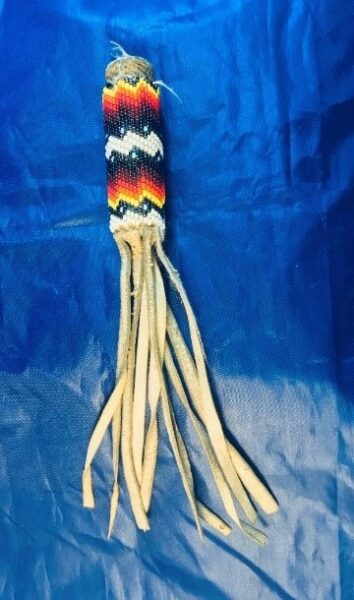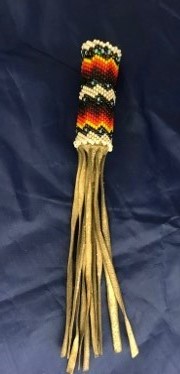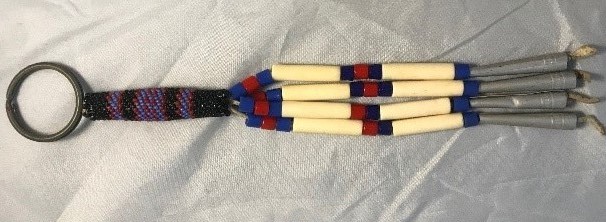
Beaded Keychain Fob
Sioux (Lakota) culture
20th century
Glass seed beads, wood, and leather
L. 2 cm x W. 2 cm x H. 17 cm
BFCP collection #2014.33

Beaded Keychain Fob
Sioux (Lakota) culture
20th century
Glass seed beads, wood, and leather
L. 2 cm x W. 2 cm x H. 17 cm
BFCP collection #2014.33

One-Drop Gourd Stitch Beaded Keychain Fob
Great Plains cultures
Late 20th century
Beads, bone hairpipes, leather, and metal cone, L. 3 cm x W. 15 mm x H. 21 cm
Hernandez collection #2014.1

One-Drop Gourd Stitch Beaded Keychain Fob
Great Plains cultures
Late 20th century
Beads, bone hairpipes, leather, and metal cone, L. 3 cm x W. 15 mm x H. 21 cm
Hernandez collection #2014.1
These two cylindrical, elaborately beaded forms used as keychain fobs are pieces that actually originate from the beaded handles made for Lakota prayer feathers. Prayer feathers are used in smudging ceremonies, which are often done during healing rituals. In this ceremony, a healer or religious specialist burns a smudge stick made of sacred herbs in a special bowl. The sacred herbs may consist of cedar, sage, sagebrush, sagegrass, sweetgrass, tobacco, or yarrow, which are gathered, dried, and then tied together into smudge stick bundles. While burning the smudge stick, the healer or religious specialist uses the prayer feather to fan the smoke over the person being treated. The smudging ritual is believed to cleanse a person’s body, mind, and spirit.
These two keychain fobs are decorated with intricate, colorful beaded designs and leather tassels, and one is additionally decorated with bone hairpipes beads and metal cones. Hairpipe beads are traditionally used for chokers, for men’s breastplates, and as trade items, while metal cones were used as additional decoration on a wide variety of objects. In general, the more elaborate the decoration, the more highly valued these objects become. Beaded keychain fobs like these are commonly made for personal use and for sale in the tourist trade.
For more information, you may contact the researcher(s) noted in the title of this exhibit entry, or Dr. Billie Follensbee, the professor of the course, at BillieFollensbee@MissouriState.edu

